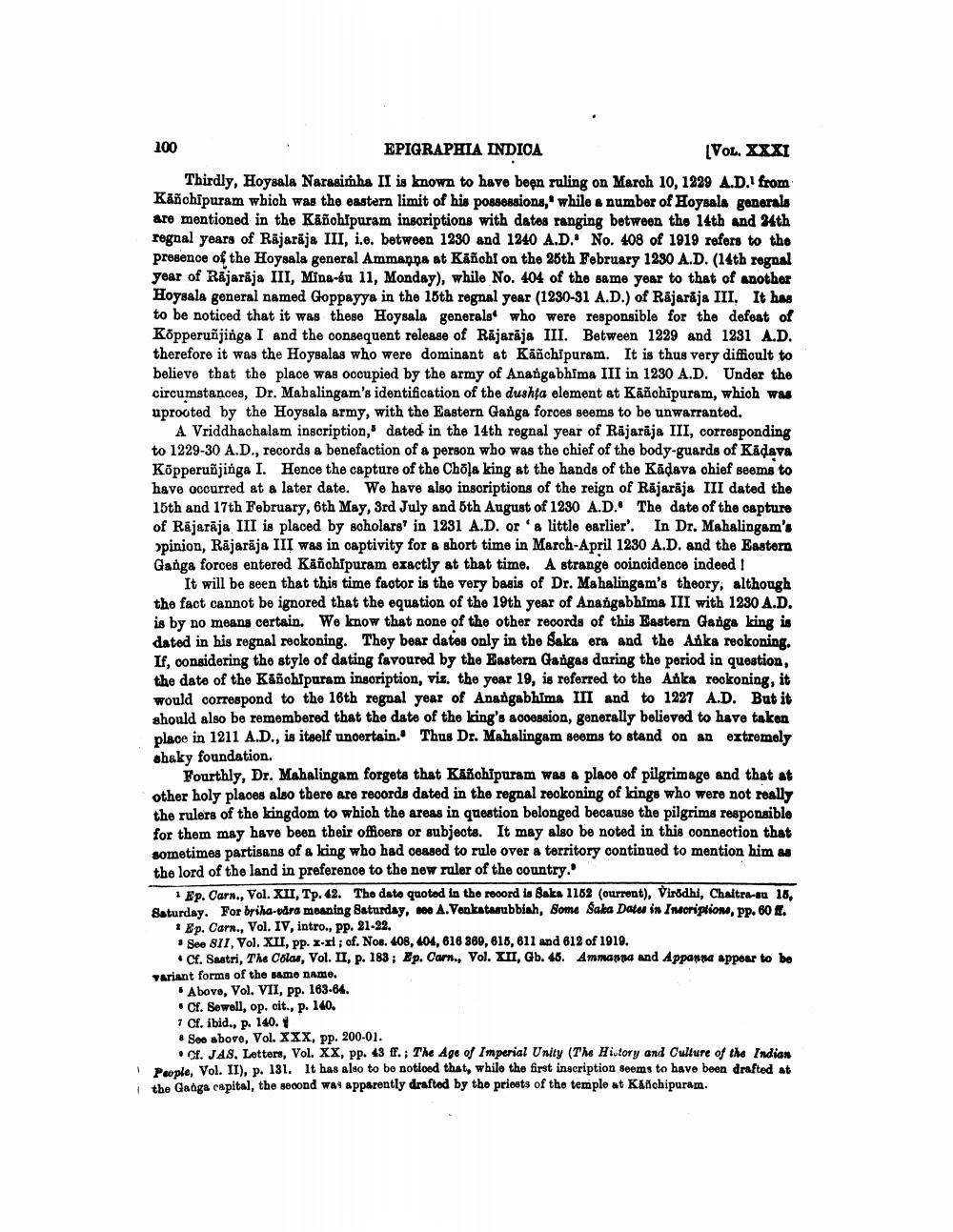________________
100 EPIGRAPHIA INDICA
[VOL. XXXI Thirdly, Hoysala Narasimha II is known to have been ruling on March 10, 1229 A.D. from Kāñchipuram which was the eastern limit of his possessions," while a number of Hoysala generals are mentioned in the Kāñohipuram insoriptions with dates ranging between the 14th and 24th regnal years of Rajaraja III, i.e. between 1230 and 1240 A.D. No. 408 of 1919 refers to the presence of the Hoysala general Ammanna at Kāñoht on the 28th February 1290 A.D. (14th regnal year of Rājarāja III, Mina-su 11, Monday), while No. 404 of the same year to that of another Hoysala general named Goppayya in the 15th regnal year (1230-31 A.D.) of Rajaraja III. It has to be noticed that it was these Hoysala generals who were responsible for the defeat of Kõpperuõjinga I and the consequent release of Rājarāja III. Between 1229 and 1231 A.D. therefore it was the Hoysalas who were dominant at Käñchipuram. It is thus very diffioult to believe that the place was occupied by the army of Anangabhima III in 1230 A.D. Under the circumstances, Dr. Mabalingam's identification of the dushta element at Kāñohipuram, which was uprooted by the Hoysala army, with the Eastern Ganga forces seems to be unwarranted.
A Vriddhachalam inscription,' dated in the 14th regnal year of Rājarāja III, corresponding to 1229-30 A.D., records a benefaction of a person who was the chief of the body-guards of Kādava KÕpperuñjinga I. Hence the capture of the Chola king at the hands of the Kādava chief seems to have occurred at a later date. We have also inscriptions of the reign of Rajaraja III dated the 15th and 17th February, 6th May, 3rd July and 5th August of 1230 A.D. The date of the capture of Rajarāja III is placed by scholars" in 1231 A.D. or a little earlier'. In Dr. Mahalingam's opinion, Rājarāja III was in captivity for a short time in March-April 1230 A.D. and the Eastern Ganga forces entered Käñohipuram exactly at that time. A strange coincidence indeed!
It will be seen that this time factor is the very basis of Dr. Mahalingam's theory, although the fact cannot be ignored that the equation of the 19th year of Anangabhima III with 1290 A.D. is by no means certain. We know that none of the other records of this Eastern Ganga king is dated in his regnal reckoning. They bear dates only in the Saka era and the Anka reckoning. If, considering the style of dating favoured by the Eastern Gangas during the period in question, the date of the Kanchipuram insoription, viz. the year 19, is referred to the Adka reckoning, it would correspond to the 16th regnal year of Adangabhima III and to 1227 A.D. But it should also be remembered that the date of the king's 8000ssion, generally believed to have takon place in 1211 A.D., is itself uncertain. Thus Dr. Mahalingam seems to stand on an extremely shaky foundation.
Fourthly, Dr. Mahalingam forgets that Kanchipuram was a place of pilgrimage and that at other holy places also there are records dated in the regnal reokoning of kings who were not really the rulers of the kingdom to which the areas in question belonged because the pilgrims responsible for them may have been their officers or subjects. It may also be noted in this connection that sometimes partisans of a king who had ceased to rule over a territory continued to mention him as the lord of the land in preference to the new ruler of the country.
1 Ep. Carn., Vol. XII, Tp. 42. The dato quoted in the record in Baka 1162 (ourrent), Virddhi, Chaitre-da 16. Saturday. For briha-udra meaning Saturday, 10 A.Venkatasubbiah, Soms Saka Datur in Indoripliom, pp. 60 .
1 Ep. Carn., Vol. IV, intro., pp. 21-22. • See 811, Vol. XII, pp. I-al; of. Nos. 408, 404, 616 869, 818, 611 and 612 of 1919.
*Cf. Sestri, The Colas, Vol. II, p. 188; Ep. Cam., Vol. XII, Gb. 45. Ammanna and Appanna appear to be variant forms of the same name.
. Above, Vol. VII, pp. 163-64. . Cf. Sewell, op. cit., p. 140. 1 Cf. ibid., p. 140. 1 # Seo above, Vol. XXX, pp. 200-01.
. CL. JAS. Letters, Vol. xx, pp. 43 ff.; The Age of Imperial Unity (The History and Culture of the Indian People, Vol. II), p. 131. It has also to be notioed that, while the first inscription seems to have been drafted at the Ganga capital, the second was apparently drafted by the priests of the temple at Kanchipuram.




